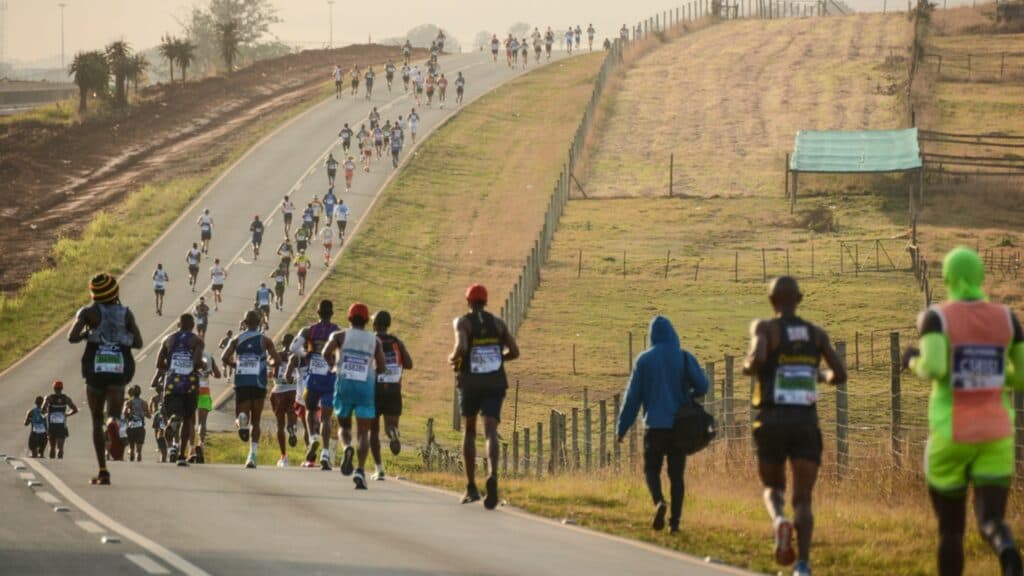Running the Comrades Marathon is a formidable challenge that tests both the physical and mental endurance of participants.
As the world’s oldest and largest ultramarathon race, it demands careful planning, strategic pacing, and sheer determination to conquer its grueling course.
In this article, I delve into the question posed by Nicole, a first-time participant, regarding the optimal pace for the race. Drawing insights from a transcript of the Ask Coach Parry podcast, we explore the significance of pacing, strategies to avoid cramping, and how to strike the right balance between speed and endurance.

How slow is slow? When it comes to finishing Comrades
Your apprehensions about the Comrades Marathon reflect common anxieties among novice and experienced runners alike.
Your first concern probably revolves around the dreaded phenomenon of cramping, a painful experience that can derail even the most well-prepared athletes.
Secondly, let’s seeks clarity on the concept of pacing—specifically, how slow is too slow when tackling a race of such magnitude.
Qualifying Marathon Time: A Benchmark for Performance
One key metric that provides insight into a runner’s potential performance in the Comrades Marathon is their qualifying marathon time.
If you completed your qualifying marathon in 4 hours and 46 minutes, this serves as a crucial reference point for estimating your finishing time in the ultra event.
Based on that marathon time, I suggest that you can expect to finish the Comrades Marathon within the range of 11 hours and 30 minutes to 11 hours and 40 minutes. This estimation forms the basis for devising a pacing strategy tailored to your abilities and goals.

The Importance of Starting Slow at The Comrades Marathon
Starting slow serves two essential purposes: conserving energy for the latter stages of the race and adapting to the relentless inclines that define the Comrades course.
Comrades marathon runners’ comfort pace of 7 minutes to 7 minutes and 30 seconds per kilometre translates to a feasible average pace for the marathon.
However, I advise them to err on the side of caution and target a slightly slower pace of around 7 minutes and 20 seconds per kilometre for the early stages of the race.
By incorporating intermittent walk breaks, runners can maintain an average pace of approximately 7 minutes and 30 seconds per kilometre, thus conserving energy and minimizing the risk of burnout.
Strategies for Success At The Comrades Marathon
To navigate the challenges posed by the Comrades Marathon, runners must adopt a multifaceted approach that encompasses pacing, hydration, nutrition, and mental resilience. Implementing the following strategies can enhance their chances of completing the race successfully:
- Gradual Acceleration: While it may be tempting to push the pace early on, runners should resist the urge and focus on building momentum gradually. By maintaining a steady rhythm and conserving energy, they can preserve their strength for the latter stages of the race.
- Hydration and Nutrition: Proper hydration and nutrition are critical components of endurance racing. Runners should adhere to a structured fueling plan, consuming carbohydrates, electrolytes, and fluids at regular intervals to sustain their energy levels and prevent dehydration.
- Mindful Monitoring: Throughout the race, runners should listen to their bodies and adjust their pace accordingly. Paying attention to signs of fatigue or discomfort allows them to make informed decisions about when to push harder or ease off the throttle.
- Positive Mindset: Mental fortitude plays a central role in ultramarathon racing. By maintaining a positive outlook and focusing on incremental goals, runners can overcome moments of doubt or fatigue and stay on track towards the finish line.

The Crucial Stage: 50 Kilometers and Beyond
I need to highlight, that the midpoint of the race marks a pivotal juncture where runners must reassess their strategy and prepare for the challenges ahead.
From the 50-kilometre mark onwards, fatigue sets in, and the terrain becomes increasingly demanding. This phase necessitates a strategic shift, with runners gradually ramping up their pace and capitalizing on any time reserves accumulated earlier in the race.
In the quest to conquer the Comrades Marathon, pacing emerges as a central tenet of success.
For Comrades marathon runners and countless other participants, striking the right balance between speed and endurance is paramount to achieving their goals.



Comments are closed.